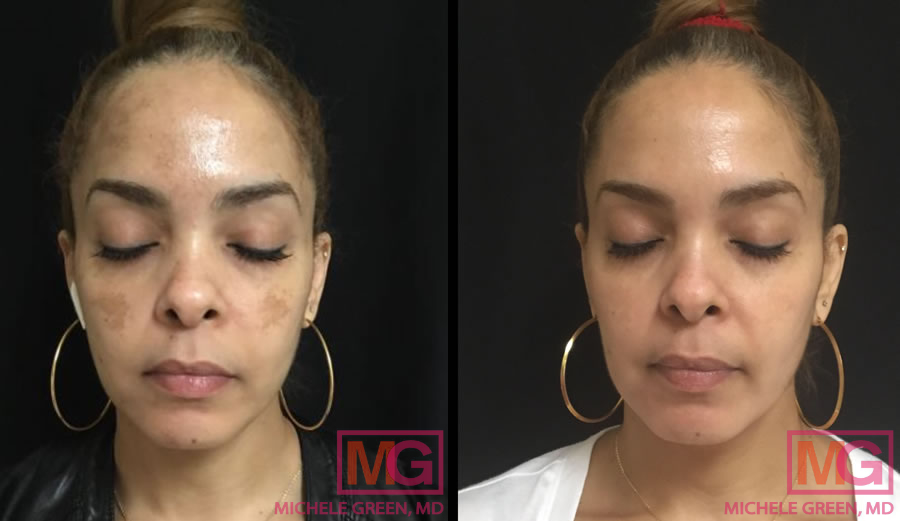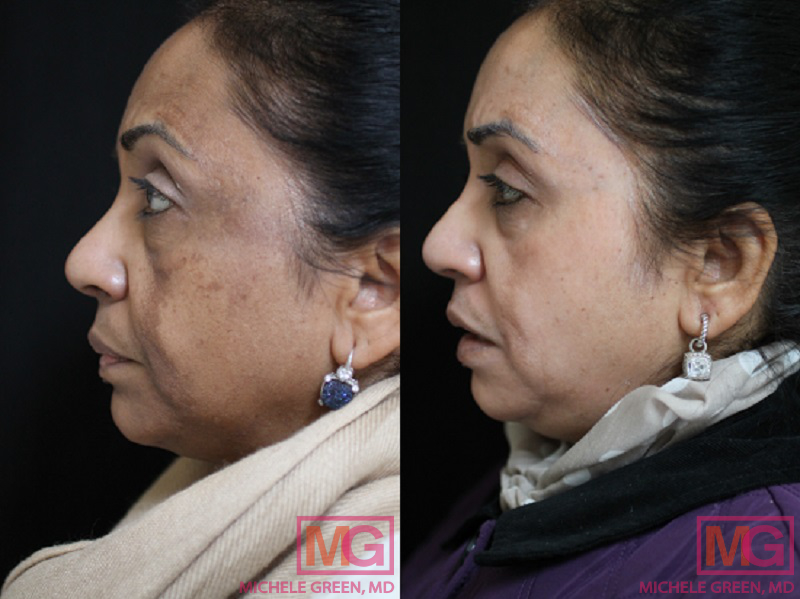Sunspots for Skin & Sunspot Removal Treatment
How to Remove Sunspots on Your Skin
Throughout our lives, we are often exposed to the sun’s rays. Going outside without protective clothing or sunscreen can leave our skin vulnerable to UV radiation, which over time can lead to the formation of dark spots. The appearance of sunspots is very common and completely harmless; however, having these signs of aging can be distressing. Sunspots, also known as age spots, are flat, brown marks that develop on areas of the body most frequently exposed to direct sunlight, including the face, shoulders, arms, and hands. Repeated exposure to ultraviolet light stimulates pigment cells to increase melanin production, resulting in deeper skin pigmentation and the formation of sunspots. While this increased melanin production is a protective response that helps prevent our skin from burning, it unfortunately has the side effect of creating new sunspots and dark spots on the face and body. Sunspots will not disappear on their own and require intervention to eliminate them. Fortunately, many dermatological treatments are available at Dr. Michele Green’s private NYC dermatology office to reduce the appearance of sunspots.
There are several treatment options available for removing age spots. These treatments focus on eliminating unwanted pigmentation and promoting new collagen production, which further contributes to healthier and younger-looking skin. Options for age spot treatment include Fraxel, Clear + Brilliant, Alex-TriVantage, Intense Pulsed Light (IPL), microneedling, TCA peels, Mesopeels, and Cosmelan. Prescription-strength bleaching creams, such as hydroquinone, along with specialized skin care products, can also help reduce melanin production and eliminate pigmentation from the skin. When selecting an age spot treatment, it is advisable to consult a board-certified dermatologist like Dr. Green, who can assist you in determining the most effective treatment plan for achieving clear, radiant skin that lasts.
Dr. Michele Green is an expert in treating sunspots, discoloration, and other hyperpigmentation disorders in her private NYC Upper East Side office. A world-renowned, board-certified dermatologist, Dr. Green is exceptionally skilled at removing sunspots and facial pigmentation and is always at the forefront of safe and effective treatments, including lasers such as Alex-Trivantage, Fraxel, and Clear+Brilliant, as well as chemical peels like Cosmelan and Mesopeel. Her expertise and commitment to her patients consistently earn her recognition as a top dermatologist in New York City by Castle Connolly, New York Magazine, Super Doctors, and The New York Times. If you are tired of the appearance of facial or body discoloration, sunspots, or age spots, Dr. Green will develop a customized treatment plan for you, incorporating the best treatments and skincare to help you achieve and maintain even, beautiful, clear skin.
What are sunspots?
Sunspots, also known as solar lentigines, are flat, pigmented areas that range in color from tan to dark brown. As we age, the effects of frequent unprotected sun exposure become visible on our skin in the form of sunspots. Ultraviolet (UV) light can accelerate melanin production in the skin, which is a naturally occurring pigment that gives the skin its color. Often, sunspots appear on individuals with fair skin who have spent considerable time in the sun, although they can develop in people of all skin types and tones. Sunspots vary in size and shape and frequently develop on the face, shoulders, arms, and hands. While sunspots are extremely common, they tend to affect individuals over the age of 40 more often. Sunspots, or age spots, are primarily caused by the extent of sun damage sustained throughout life and an individual’s genetic predisposition to producing these dark spots. Increased sun exposure leads to a greater number of sunspots and deeper pigmentation. Although sunspots are harmless, unlike freckles, they do not fade over time and can only be removed through dermatologic treatments such as chemical peels or lasers.
What do sunspots look like on your skin?
Sunspots are flat areas of skin discoloration that can range from light tan to brown, encompassing various shades in between. These dark spots also vary in size and typically range from the size of a freckle to 1/2 inch in diameter. They are textureless and can appear on any sun-exposed areas of your body, including the face, neck, décolletage, shoulders, back, legs, and tops of your hands. Caused by excessive sun exposure, age spots typically develop in adults over 50, although increased sun exposure in youth can lead to their appearance in younger individuals. Unlike freckles, which fade in children, sunspots remain on the skin, contributing to a speckled appearance.
What causes sunspots on the skin?
Sunspots develop over time due to the accumulation of sun exposure. Exposure to the sun during childhood results in freckles on frequently exposed areas. As we age and experience more sun exposure, we develop larger and more prominent pigmented lesions known as sunspots. These spots form as a result of intense or cumulative exposure to UV rays from the sun. UV rays are absorbed by our skin, causing the melanocytes in that area to multiply. Melanocytes are the pigmented skin cells responsible for producing and transferring melanin, the chemical that gives our skin its color. With repeated sun exposure, melanin accumulates in the skin, forming a dark spot. The purpose of melanin is to absorb UV rays and protect the DNA in our skin, which is why sunspots develop as a means of protection. A history of repeated sunburns increases the risk of skin cancer and can also heighten the presence of sunspots. These sunspots deepen over time and are commonly found in areas exposed to the sun, such as the face, chest, neck, back, legs, and hands. In fact, sunspots on the hands are among the first visible signs of aging for many people.
Are sunspots skin cancer?
No, sunspots are not harmful or cancerous and typically do not require medical intervention. They result from accumulated sun exposure, leading to increased melanocytes and melanin pigment in the skin. While sunspots can sometimes resemble skin cancer, they are harmless and usually do not necessitate medical treatment. However, many patients choose to address age spots for cosmetic reasons, seeking a more even skin tone and a restored youthful appearance. If any dark spots on the skin change in size or color, it may indicate a potential risk of cancer. In this case, it is advisable to consult a board-certified dermatologist, such as Dr. Green in NYC, who can assess whether the lesion is an age spot or a type of skin cancer. If needed, she can perform a skin biopsy for laboratory evaluation to rule out skin cancer. Dr. Green has over twenty-five years of experience in dermatology, which includes both the medical treatment of skin cancer and the cosmetic removal of sunspots. Regardless of the type of dark spots, Dr. Green is ready to assist you.
What’s the difference between age spots and sun spots?
Age spots, also referred to as sun spots, develop from excessive exposure to harmful UV rays. Other names for these spots include liver spots and solar lentigines. Prolonged sun exposure can enhance melanin production by the melanocytes in your skin, resulting in the formation of dark spots. While liver spots are harmless, they can be an annoying reminder of the natural aging process. Fortunately, various options exist for removing liver spots. Treatment options at Dr. Green’s Upper East Side dermatology office include laser therapy, chemical peels, intense pulsed light treatment, Hydrafacials, mesopeels, skin-lightening creams, and microneedling to eliminate age spots from the skin.
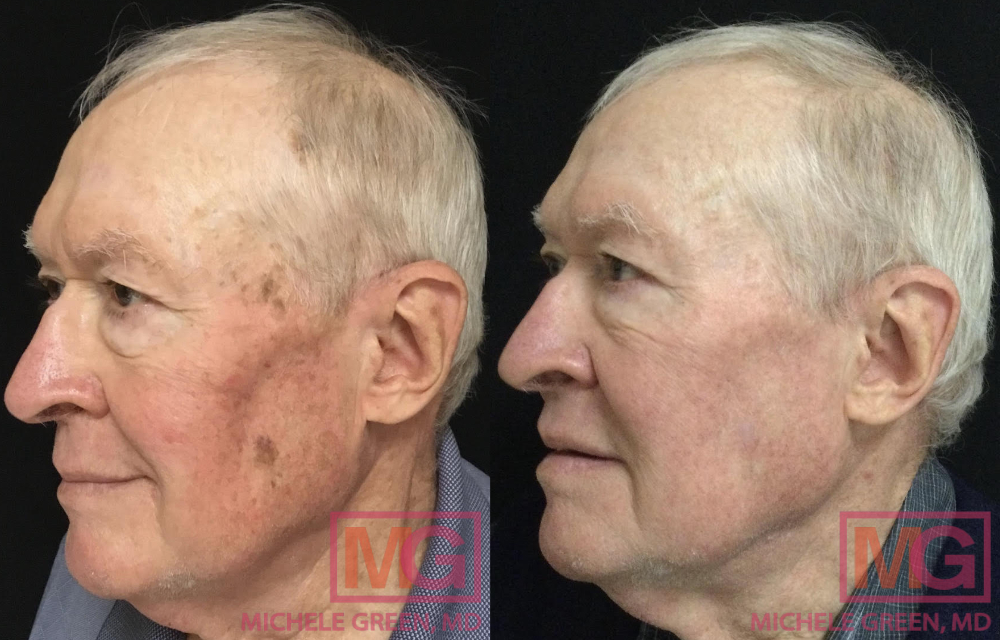
AlexTrivantage laser and Fraxel before and after
Will sunspots go away on their own?
Unfortunately, sunspots generally do not fade or disappear on their own. They occur due to sun damage, and eliminating them requires treatment from a board-certified dermatologist. However, laser treatments such as Alex-Trivantage and Fraxel, along with chemical peels like Cosmelan or Mesopeel, are safe and effective options for removing sunspots from the skin’s surface. After treatment, sunspot removal is permanent as long as you avoid excessive sun exposure, wear a hat and protective clothing, and continue using effective skincare products.
How to get rid of sunspots?
When it comes to removing sunspots and other types of skin discoloration, various non-invasive treatment options are available at the New York City office of board-certified cosmetic dermatologist Dr. Michele Green. Dr. Green offers a range of services tailored to her patients’ unique needs, including laser treatments, microneedling, chemical peels, Cosmelan, Mesopeels, and topical skincare products. Dr. Green will evaluate the treatment method or combination of treatments best suited for your hyperpigmentation based on your skin tone and type during your consultation at her private dermatology office in NYC.
Candela Alex-Trivantage Laser
The Candela Alex-Trivantage Laser is a YAG laser designed to treat specific sunspots. It operates by emitting wavelengths of light that are absorbed by the pigment in the dark spots on the skin. These melanin-rich lesions convert light energy into heat, which eliminates the pigmentation and stimulates the production of new, lighter, and healthier skin cells. The laser specifically targets pigmentation in the skin, ensuring that the surrounding tissue remains unaffected by the treatment. Results from the Candela Alex-Trivantage laser treatment can typically be seen within one to two weeks following the procedure. While patients usually require one to two treatments for optimal results, the number of sessions needed will vary depending on the severity of the pigmentation. In addition to treating sunspots and age spots, the Alex-TriVantage laser can also remove tattoos, including black, blue, red, and green pigments.
Fraxel Laser
The Fraxel laser was the first FDA-approved fractional laser designed to treat sun damage, sun spots, skin texture, stretch marks, acne scars, fine lines, and wrinkles. It resurfaces a “fraction” of the skin, leaving the surrounding tissue unaffected to minimize downtime and expedite healing. The Fraxel Dual utilizes two light wavelengths: 1927 nm, which primarily targets pigmentation and sun damage, and 1550 nm, which addresses fine lines, wrinkles, and acne scars. The laser generates thousands of controlled, microscopic injuries to the skin, stimulating the natural healing process and enhancing collagen production as well as the creation of new, smooth skin cells. When using the 1927 nm wavelength setting, the Fraxel laser focuses on and eliminates melanin in pigmented cells while preserving the surrounding skin. A combination of both settings can effectively treat sun spots and wrinkles simultaneously while improving skin texture, all with only a few days of recovery. Multiple sessions of Fraxel should be arranged to eliminate sun damage and achieve optimal cosmetic results effectively. Dr. Green recommends scheduling three treatment sessions for maximum benefit, with each session spaced a month apart. The Fraxel laser is most effective for lighter skin tones.
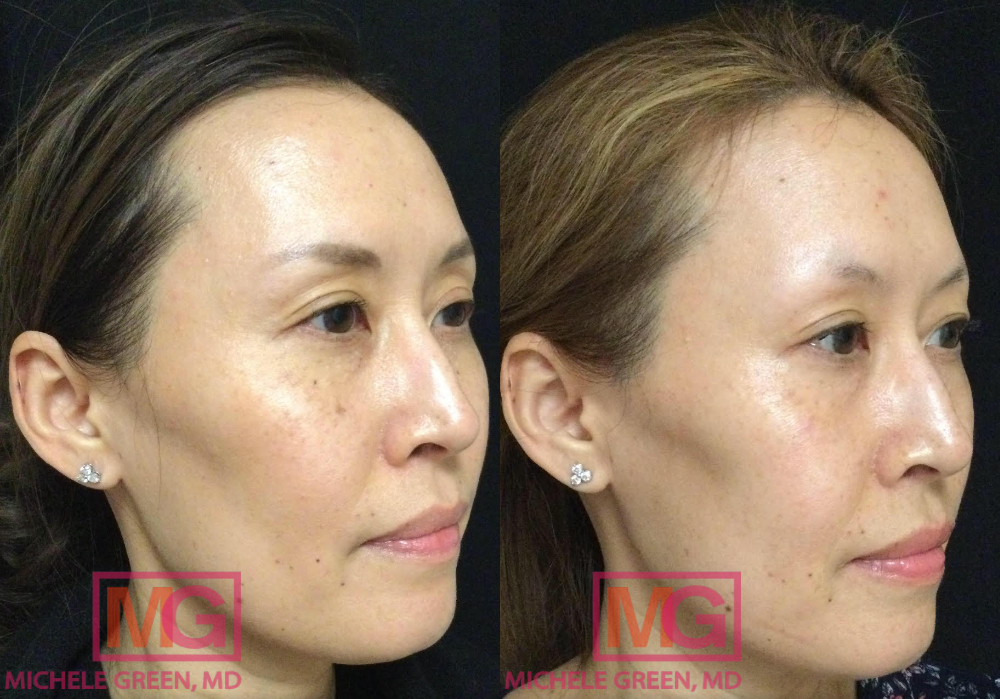
42 year old female before and after sun spot treatment with AlexTrivantage laser
Clear+Brilliant Laser
The Clear+Brilliant laser is often called a “mini-Fraxel” laser. This gentle laser resurfacing treatment received FDA approval in 2011. Utilizing fractionated laser technology, Clear+Brilliant creates millions of microscopic treatment zones on the face, stimulates new collagen production, removes dead skin cells, and encourages the formation of healthy new skin. Clear+Brilliant effectively addresses many skin conditions, including overall sun damage, sunspots, uneven skin tone, irregular skin texture, fine lines, and enlarged pores. Patients of all skin types, including those with darker complexions, can benefit from the Clear+Brilliant laser treatment for comprehensive facial rejuvenation. Typically, five treatments spaced a month apart are recommended for optimal results. The Clear+Brilliant laser requires no downtime, making it an excellent choice for eliminating sunspots and achieving beautiful, younger-looking skin.
Intense Pulsed Light (IPL)
The Intense Pulsed Light (IPL) laser treatment, also known as a photo facial, reduces unwanted pigmentation, facial redness, fine lines, and skin laxity to enhance the overall color and texture of the skin. Intense Pulsed Light differs from laser resurfacing in that, while lasers typically use a single wavelength of light, IPL lasers employ several different wavelengths of light to smooth the skin and diminish the appearance of discoloration, brown spots, sun damage, and other signs of aging. The flash of light emitted from the IPL device penetrates the dermal layer of the skin to target and destroy the melanin-rich cells in sunspots. The photo-facial (IPL) procedure is quick and effective, causing minimal discomfort and requiring no downtime. However, Dr. Green advises continuing to avoid sun exposure as much as possible and to wear sunscreen and protective clothing, such as a wide-brimmed hat, whenever outdoors.
TCA Chemical Peels
A TCA peel involves the application of trichloroacetic acid, a chemical solution, to the skin to exfoliate the top layer of dead, pigmented skin cells. The removal of these dead and pigmented cells stimulates the production of new skin, resulting in a more even, brighter, and healthier-looking complexion. Various strengths of TCA can be used based on the severity of pigmentation and the patient’s skin type and tone. In addition to diminishing sun spots, TCA peels can enhance skin texture and reduce fine lines, wrinkles, acne scars, enlarged pores, and other visible signs of aging. Patients may require five or six peels to achieve optimal cosmetic results. Side effects of the peel can include redness and flaking that generally resolve in a few days after the peel. TCA peels are generally not advisable for patients with darker skin tones due to the heightened risk of post-peel discoloration.
Cosmelan Peel
The Cosmelan Peel is a professional-grade chemical peel treatment available at Dr. Michele Green’s office. It features a proprietary blend of active ingredients that delivers highly effective skin-lightening results. The Cosmelan Peel mask operates through multiple mechanisms to eliminate pigmentation in the affected areas and prevent further melanin accumulation. This specialized chemical peel removes dead, pigmented cells from the skin, revealing the healthy, clear skin beneath while inhibiting pigmented cells from migrating to the epidermis (the top layer of the skin). During your appointment, Dr. Green will apply the Cosmelan Peel to the targeted area. The duration for which the mask should be worn will be determined based on the severity of sunspots, pigmentation, or melasma, as well as the location of the pigmentation. Patients will then remove the mask at home using a gentle cleanser.
Dr. Green has designed a personalized skincare routine for her patients to follow after the treatment. This skincare routine incorporates creams from her MGSKINLABs, enhancing treatment results and protecting your skin from further pigmentation. These creams may contain active ingredients such as Kojic acid, azelaic acid, hydroquinone, and hydra-vital factor K. Additionally, Dr. Green advises strict sun avoidance post-treatment to prevent any further damage from UV rays. If sun exposure is unavoidable, she recommends using a combination of chemical and physical sunscreens for optimal effectiveness protection.
Mesopeels
Mesopeels are a type of chemical peel offered at Dr. Green’s office, specifically designed to treat sensitive areas of the skin. They contain gentle skin-lightening ingredients that effectively eliminate various forms of hyperpigmentation, including sun spots. The Mesopeel functions similarly to other chemical peels by gently exfoliating the skin, removing dead skin cells, and promoting new collagen production for rejuvenated skin. It can be used to address hyperpigmentation in different parts of the body, including the face, neck, back, and underarms. Mesopeels are particularly effective for sensitive areas and typically involve little discomfort or recovery time. Generally, four to six treatments are needed to achieve optimal results. There is no downtime, allowing patients to resume their daily activities immediately after the procedure.
Microneedling with skin depigmentation solution
Microneedling, also known as collagen induction therapy, is a highly effective skin rejuvenation treatment that targets fine lines, wrinkles, and acne scars while improving pigmentation. This technique uses tiny, insulated, surgical-grade needles to create micro-injuries in the epidermal layer of the skin. The microchannels formed during the procedure enhance the absorption of serums and skincare products. The needle pricks initiate the body’s natural healing response, leading to the production of new collagen and healthy skin cells, which reduces the appearance of sun spots, improves skin texture, and treats acne scars. For patients primarily focused on addressing hyperpigmentation—whether it manifests as sun spots, melasma, or pigmented acne scars—adding a depigmenting serum to the microneedling treatment can yield outstanding results. This serum contains a unique combination of effective yet gentle skin-brightening agents that target melanocytes (the skin cells responsible for pigment production) to effectively eliminate sun spots and pigmentation. The microneedling procedure itself is quick, straightforward, and painless, and Dr. Green typically recommends five to six treatment sessions to achieve healthy, radiant, and clear skin skin.
Microdermabrasion
Microdermabrasion is a non-invasive treatment that gently removes the outermost epidermal layer of the skin to even out texture and eliminates discoloration and fine lines. This treatment is an excellent choice for individuals with sun-damaged skin, age spots, acne scars, or skin discoloration. The procedure exfoliates the skin using a fine abrasive tip or crystals, removing dead skin cells and promoting the production of new, lighter skin cells in the treatment area. Results of the procedure are best achieved after several treatment sessions, each spaced about a month apart. The procedure is safe for all skin types and requires no downtime; however, patients should commit to a rigorous sunscreen regimen after treatment.
HydraFacials
A HydraFacial is a three-step, medical-grade facial designed to rejuvenate the skin and address concerns such as pigmentation, acne, and redness. It is safe and effective for all skin tones. Conducted at Dr. Green’s office, the HydraFacial begins with the cleansing phase, which removes dead skin cells from the skin’s surface while simultaneously hydrating it. After cleansing, the second step is exfoliation. During the HydraFacial, a chemical exfoliant is applied to soften debris trapped in the pores before the skin is exfoliated. A proprietary vortex suction machine is equipped with a specially designed tip to extract dead skin cells and dirt. Finally, the third step rejuvenates the skin with serums and moisturizers. The HydraFacial can be enhanced with boosters or specialized serums to target specific skin issues, such as redness, uneven skin tone, pigmentation, and fine lines. Boosters like HydraFacial Brighten or Murad Vita-C can be added to provide antioxidants and skin-brightening ingredients, helping to diminish the appearance of sunspots. Dr. Green utilizes custom-designed skin care treatments to revitalize the skin, leaving you with a youthful, fresh appearance free of blemishes and pigmentation.
Cryosurgery
In the past, cryotherapy using liquid nitrogen was a popular treatment option for sunspot removal; however, cryotherapy can cause significant skin irritation and tissue damage and is not typically used anymore. Today, there are many different techniques used for removing sunspots that have fewer adverse effects. These treatments can work on various treatment areas, including the face, neck, scalp, hands, arms, legs, back, chest, and décolletage. An expert like Dr. Green can remove sunspots in virtually any area of the body and uses a combination of treatments based on the distribution of your sunspots and skin tone.
Skin Care Products and Creams
With numerous topical skincare products available for pigmentation, it can be difficult to determine which product is best for you. Founded by board-certified dermatologist Dr. Michele Green, MGSKINLABs Inc. offers some of the best skin-lightening creams and lotions designed to treat sunspots. Dr. Green develops tailored pigment protocol regimens for her patients, incorporating the safest and most effective topical creams, moisturizers, and cleansers suitable for each skin tone and type. When consulting with Dr. Green about the most effective treatment plan for your sunspots, she will recommend specific creams, serums, skin-lightening products, and sunscreens from her MGSKINLABS product line that best meets your individual needs. Each product is proven to effectively reduce pigmentation and promote healthy, smooth, and radiant skin. The Vita-C Serum boasts a high potency of vitamin C while remaining gentle on the skin. Vitamin C serves as a powerful antioxidant that enhances skin cell turnover, shields against oxidative stress, and minimizes pigmentation and dark spots. MGSKINLAB’s Skin Brightening Cream is another outstanding product that incorporates skin-lightening ingredients, such as kojic acid and fruit extracts, to brighten the skin and eliminate pigmentation gently.
Dr. Green may suggest adding hydroquinone, a topical skin-lightening cream, to your skincare routine. Hydroquinone blocks melanin production and prevents melanocytes from reaching the upper layers of the skin. It is available only with a prescription from a board-certified dermatologist. It is essential to follow the directions of the prescribing healthcare provider when using the cream; overusing hydroquinone can actually worsen hyperpigmentation through a process known as ochronosis. Additionally, it may cause skin irritation, especially for those with sensitive skin, and can increase sensitivity to light. Therefore, wearing sunscreen and minimizing sun exposure while using hydroquinone is crucial.
Retinoids are a highly effective prescription cream for eliminating sunspots. Derived from vitamin A, retinoids enhance skin cell turnover, sloughing off dead, pigmented cells to reveal fresh, bright skin cells underneath. They also boost collagen production, improving skin texture and rejuvenating the skin. Proper sun protection is essential when using retinoids, as they can increase the skin’s sensitivity to sunlight. Prescription retinoids like Retin-A and tretinoin are available only from a board-certified dermatologist, while retinol can be purchased over the counter. Dr. Green’s MGSKINLAB skincare line features an Essential Antioxidant Infusion serum rich in retinol, vitamins C and E, and other nutrients to exfoliate and replenish the skin.
The final and most crucial part of the pigment protocol for reducing sunspots and other forms of unwanted skin pigmentation is sunscreen. Dr. Green offers both chemical and physical sunscreen at MGSKINLABs Inc. When undergoing sunspot treatment, Dr. Green recommends using both types of sunscreen for added protection. Chemical sunscreen absorbs UV rays, converting them into heat energy that is then released from the skin, while physical sunscreen sits on the skin’s surface and reflects the sun’s rays. A broad-spectrum sunscreen with an SPF of 50 provides the best protection against both UVA and UVB rays. In addition to preventing the formation of pigmented spots, sunscreen plays a vital role in skin health, decreasing the chances of skin cancers forming.
55-64 year old woman treated with Cosmelan & Chemical Peels
FAQs about Sunspots:
What do cancerous sun spots look like?
While sunspots are not cancerous, some cancerous lesions can resemble them. The American Academy of Dermatology uses the “ABCDEs” of skin cancer to determine if a dark spot may be cancerous. ABCDE stands for asymmetry, border, color, diameter, and evolving. Most melanomas are darker and have irregular borders, while sunspots and solar lentigines are typically smaller and more uniform in shape. If any dark spots on the skin change in size or color, it may indicate that the spot could be cancerous. Sometimes, it can be difficult to differentiate between a sunspot and skin cancer, as many types of skin cancers, such as actinic keratoses and basal cell carcinomas, can resemble sunspots. However, a board-certified dermatologist like Dr. Michele Green can recognize the difference between a benign and a malignant lesion. Skin cancer is on the rise in the United States, and identifying and treating these lesions early is more important than ever. Careful examination of a dark lesion and biopsy may be indicated to be certain of the correct diagnosis and treatment. Dr. Green is a member of the American Academy of Dermatology and recommends yearly skin cancer examinations to diagnose, treat, and prevent skin cancer.
How do you remove sun spots on your face?
A common question in Dr. Green’s private dermatology office is, “How to remove sunspots from your face?” There are various treatment options for eliminating dark brown sun spots on the face, including topical lightening creams. Key active ingredients in prescription topical creams include retinoids and hydroquinone. Hydroquinone is a bleaching agent that inhibits melanin production. Melanin is the component of the skin that is responsible for its pigment or color. Hydroquinone comes in different strengths, and Dr. Green will determine the most suitable concentration based on your skin type and the severity of hyperpigmentation. In-office cosmetic procedures are often more effective than topical lightening creams alone and typically produce longer-lasting results. Dr. Green’s office offers a range of treatment options for removing age spots from the face, from chemical peels to laser resurfacing treatments. When you consult with Dr. Green about your sunspot treatment, she will evaluate your skin and create a customized treatment regimen, including topical products, in-office procedures, or a combination of treatments, to provide you with a clear, even complexion that lasts.
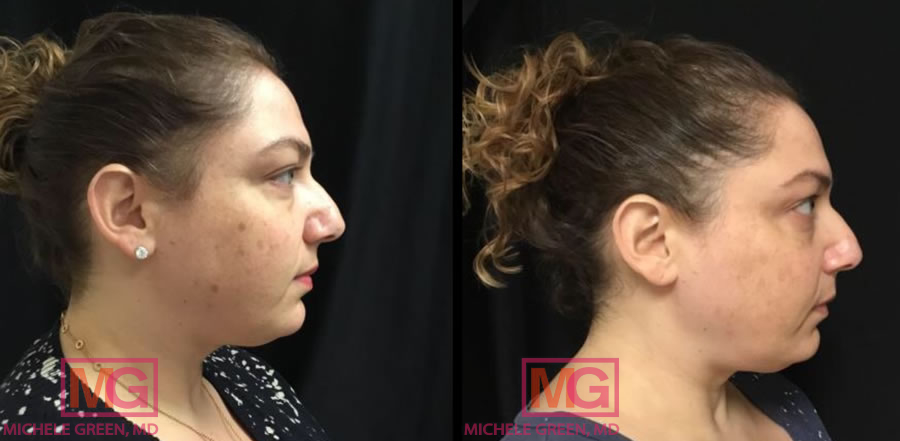
How do you remove sun spots on your arms, hands, and legs?
Fortunately, many of the effective cosmetic treatments recommended by Dr. Green for eliminating sun spots on the face are also excellent options for removing sun spots from the body. The hands and legs are among the most common areas showing signs of sun damage, including sunspots. A combination of MGSKINLABs, Inc. topical lightening creams and laser treatments like the Candela AlexTrivantage or Fraxel Dual procedures represents one of the fastest, easiest, and safest methods to reduce the appearance of sunspots on the hands and legs. These treatments can address a broader area of discoloration or dark spots in a single session. The Fraxel laser offers overall skin rejuvenation for the body, while the AlexTrivantage effectively removes darker, discrete sunspots, resulting in a beautiful, even skin tone and texture. When you consult Dr. Green at her private dermatology office on Manhattan’s Upper East Side, she will work with you to determine which laser treatments, chemical peels, and specially formulated skincare products will safely and effectively minimize the visibility of sunspots on the body.
How to lighten sun spots?
The most effective treatment for lightening sunspots typically involves a unique combination of in-office procedures and specially formulated topical skincare products, which an experienced, board-certified dermatologist like Dr. Michele Green can recommend for you. Dr. Green often employs laser treatments such as the Alex Trivantage and Fraxel, along with chemical peels like the Cosmelan peel and Mesopeel, to diminish the appearance of hyperpigmented sunspots. Additionally, Dr. Green frequently crafts a personalized skincare regimen that incorporates potent bleaching agents like hydroquinone and antioxidants such as Vitamin C. A dermatologist like Dr. Green should monitor your sunspot treatment progress to make any necessary adjustments. Some treatment options for hyperpigmentation, including topical hydroquinone products, can potentially cause skin irritation or adverse changes in skin condition with prolonged use, so it’s vital to use any prescription creams as directed by the dermatologist. When you receive sunspot treatment from Dr. Green, she will customize your treatment plan and establish a timeline that best meets your needs and goals.
How to remove sunspots on your chest?
Just like the face, the chest often receives substantial sun exposure and may exhibit signs of photoaging before the rest of the body. Many treatments that diminish the appearance of sunspots on the face are also effective for removing sunspots on the chest. Laser treatments, such as the AlexTrivantage or Fraxel lasers, use light energy to eliminate excess melanin in sunspots, resulting in a more even skin tone. Chemical peels, such as TCA peels, effectively exfoliate the dead, pigmented cells on the surface, revealing healthier skin cells beneath. Dr. Green recommends and utilizes both lasers and chemical peels as her primary methods for treating age spots due to their safety and effectiveness. When formulating a treatment plan for her patients, Dr. Green considers the size of the treatment area and the patient’s skin tone to create a plan that is safe and yields the best possible results.
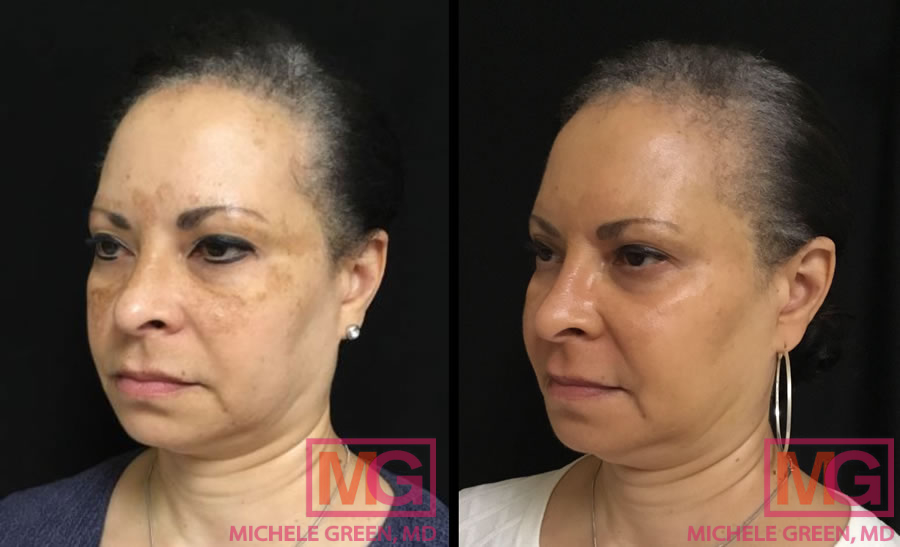
How to get rid of dark sun spots on your face?
There are numerous treatment options available at Dr. Michele Green’s NYC dermatology office for eliminating hyperpigmented brown spots on the face. Dark spots, age spots, and other forms of facial hyperpigmentation typically require more intensive treatments than over-the-counter topical creams. In-office cosmetic procedures and prescription topical creams are generally more effective for lightening dark spots and achieving longer-lasting results. Utilizing the latest and most advanced non-invasive treatment options, such as laser resurfacing technologies and medical-grade chemical peels, Dr. Green has successfully diminished the appearance of age spots for some of the most discerning men and women worldwide, providing them with an even skin tone, a radiant complexion, and an overall more youthful appearance. When you consult with Dr. Green, she will create a treatment plan tailored to give you long-lasting, optimal cosmetic results without the need for significant downtime.
How to get rid of sunspots on your lips?
Sunspots can develop on the face, including the lips. The skin on the lips is different from the rest of the face, as it lacks hair follicles and sweat glands but has increased vascularization. However, the lips can still develop sunspots, which can be quite frustrating. If you notice sunspots on or around your lips, it is crucial to consult a board-certified dermatologist. Given the delicate nature of the lips, using the appropriate treatment is essential to prevent adverse reactions or irritation. When you consult Dr. Green about your sunspots, she will create a treatment plan that safely and effectively reduces their appearance.
Does sunscreen prevent sun spots?
Yes, the best way to avoid sunspots is to practice proper sun protection and avoid unnecessary UV rays. Patients must use a broad-spectrum sunscreen with an SPF of 50 or higher to protect against both UVA and UVB rays. Dr. Green often suggests combining two different types of sunscreens, especially if there is a propensity for sunspots or melasma, to avoid developing sunspots and sun-related skin cancers. Patients should first apply a chemical sunscreen and then a physical sunscreen for the best sun protection. It is essential to apply sunscreen daily and reapply every 2 hours, especially after swimming or sweating. Individuals prone to sunspots or melasma should also wear protective clothing from the sun, including wide-brimmed hats, long-sleeved shirts, and sunglasses, and avoid the sun between the hours of 10 a.m. and 3 p.m. when it is strongest.
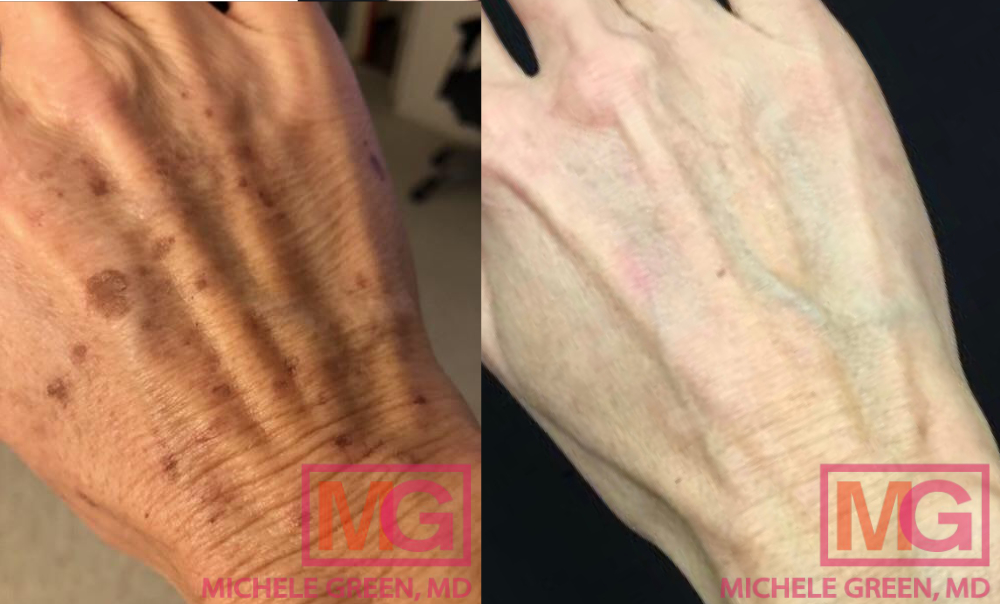
How can you naturally get rid of sunspots?
The best way to remove sun spots naturally is through the use of targeted treatments that can take advantage of the skin’s natural regenerative processes. Various topical creams and ingredients can be added to your skincare routine to treat sunspots at home. Retinol creams and lotions containing alpha hydroxy acids such as glycolic acid help exfoliate the skin and fade sunspots. Vitamin C serum, like Dr. Green’s popular Vita-C-serum, has powerful antioxidant properties to lighten sunspots and repair the effects of damaging UV rays. Skin-lightening creams containing hydroquinones, kojic acid, arbutin, phytic acid, and azelaic acid, all lighten the skin and diminish the appearance of sunspots and discoloration. Sunscreen is essential for ensuring that the skin is protected from further UV damage, which can worsen sunspots and create new ones. While topical products are effective for reducing the appearance of sunspots over time, typically, in-office treatments such as lasers and chemical peels are required to eliminate sunspots from the skin fully.
How to get rid of white sunspots?
Excessive sun exposure or the use of tanning beds can result in hypopigmentation, leading to the appearance of light spots on the affected areas. White spots resulting from too much sun exposure are referred to as idiopathic guttate hypomelanosis. This condition can be treated with topical steroids or retinoids, which reduce inflammation and promote cell turnover. Various factors can contribute to the development of white spots on the skin, making it essential to identify the source of hypopigmentation to determine the most effective treatment. Another condition that may arise from excessive sun exposure or tanning beds is Tinea versicolor, which occurs due to an overgrowth of yeast called pityrosporum on the skin’s surface. This yeast thrives on sweat, which tends to increase in sunny or humid conditions. In tanning beds, bacteria can flourish in the warm environment where many individuals sweat, facilitating the growth of pityrosporum on the skin. Typically, Tinea versicolor can be treated with antifungal medication prescribed after a diagnosis of the condition.
An underlying condition can also lead to white spots that become more noticeable due to tanning on the skin, such as vitiligo. Vitiligo is believed to be an autoimmune disorder in which white patches form on the skin due to the halted production of melanin. When patients tan, the existing vitiligo becomes more prominent against the darker skin from tanning. Several treatments can help reduce the contrast in coloration, including corticosteroid creams and UVA or UVB phototherapy. Phototherapy is beneficial for various skin conditions, including psoriasis and vitiligo. If you notice white spots on your skin, it is advisable to seek medical advice from a dermatologist, such as Dr. Green, to obtain the correct diagnosis and the best treatment plan for your condition.
How to get started with removing sunspots today
The presence of sunspots can make individuals appear significantly older than their actual age and, for many, can lead to feelings of self-consciousness or low self-esteem. Fortunately, cosmetic dermatology has advanced significantly in developing new and innovative treatments for sunspots and pigmentation. Sunspots can be treated anywhere on the body, including the face, neck, décolletage, hands, arms, legs, and back. These treatments are easy, safe, effective, and permanent, provided that proper sun protection is maintained. Whether through laser treatments or chemical peels, Dr. Green offers various non-invasive options for eliminating sunspots and achieving beautiful, healthy, and evenly toned skin.
With over 25 years of experience, Dr. Michele Green has treated some of the world’s most discerning men and women for sunspot removal using treatments like the Fraxel laser and Cosmelan peel. Her dedication to her patients has earned her consistent recognition as one of New York’s top physicians by Castle Connolly, Super Doctors, New York Magazine, and The New York Times. During your consultation with Dr. Green, she will work closely with you to fully understand your specific skin concerns and desired cosmetic outcomes. She will develop a treatment plan that includes a unique combination of in-office procedures and specially formulated skincare products. Whether you want to decrease the appearance of hyperpigmentation related to sun damage, freckles, or sunspots or rejuvenate your skin, Dr. Green can assist you. To create your personalized treatment plan for sunspot removal and consult with Dr. Green, call the New York City-based office at 212 535 3088 or contact us online today.
 212-535-3088
212-535-3088 